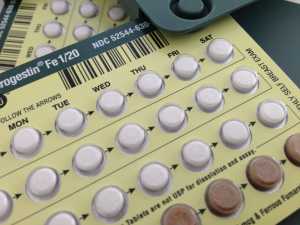Bisexual Adults Have Highest Prevalence of Sleep Problems in NYC Survey
Powerful Men More Inclined to Sexually Harass When They Fear Being Perceived As Incompetent
Cardiovascular Risks of Hormone Therapy in Transgender Individuals
- Rates of venous thromboembolism in all transwomen were approximately twice as high as the rates among cisgender men or cisgender women. The data for stroke and myocardial infarction demonstrated little difference between transwomen and cisgender men, but 80% to 90% higher rates among transwomen compared to cisgender women.
- When the analyses focused specifically on transwomen who started therapy with female hormone estrogen at Kaiser Permanente, the incidence of both venous thromboembolism and stroke was more clearly elevated relative to either reference group. There was evidence that incidence of both of these conditions among transwomen was particularly increased two to six years after estrogen initiation. By contrast, the association between estrogen therapy and myocardial infarction was less evident due to relatively few observed events.
- Transmen did not appear to have significantly higher rates of venous thromboembolism, ischemic stroke, or myocardial infarction than their non-transgender counterparts, but this group was rather young and included a relatively small proportion of participants who initiated their hormone therapy during the study.
Bisexual Men Face Greater Risk of Heart Disease
CPAP Improved Sexual Quality of Life for Women
MedicalResearch.com Interview with: [caption id="attachment_38315" align="alignleft" width="200"] One CPAP modelImage by Bryan Alexander[/caption] Sebastian M. Jara, MD Resident Physician & Research Fellow Department of...
New Male Contraceptive May Make Pregnancy An Uphill Swim
The Economic Burden of Child Sexual Abuse is in the Billions
HIV Incidence Decreasing But Not Among Latino and AA Gay and Bisexual Men
Topical Estrogen No Better Than Moisturizer for Postmenopausal Vaginal Dryness
Ixekizumab Improved Impact of Genital Psoriasis on Sexual Activity
- DLQI Item 9 0/1: 92.0 percent of patients treated with ixekizumab compared to 56.8 percent of patients treated with placebo reported no (0) or little (1) sexual difficulties caused by skin symptoms.
- SFQ Item 2 0/1: 78.4 percent of patients treated with ixekizumab compared to 21.4 percent of patients treated with placebo (reported the frequency of sexual activity was either never (0) or rarely (1) limited by genital psoriasis.
- GPSIS-Avoidance 1/2: 76.7 percent of patients treated with ixekizumab compared to 25.7 percent of patients treated with placebo reported never (1) or rarely (2) avoiding sexual activity due to genital psoriasis.
- GPSIS-Impact 1/2: 85.7 percent of patients treated with ixekizumab compared to 52.9 percent of patients treated with placebo reported worsening of genital psoriasis symptoms during or after sexual activity was very low/none at all (1) or low (2).
ZIKA: Mouse Study Finds Antioxidant Ebselen Reduces Risk of Sexual Transmission
Relationship Status Helps Determine Contraception Choice
 Marie Harvey, DrPH MPH
Lisa P. Oakley, PhD MPH
College of Public Health and Human Sciences
Oregon State University
MedicalResearch.com: What is the background for this study? What are the main findings?
Response: Because decisions about contraceptives are often made by young adults in the context of their relationships and specific partners, the characteristics of that relationship and feelings about that partner will likely influence how those decisions are made. Many studies have previously investigated individual factors that affect contraceptive choice and when examining partner influences have used questions that were not specific to a particular partner. Intuition, however, suggests that feelings for a specific partner would likely influence one’s perception of risk for disease acquisition, and thereby, their contraceptive choice. So, it was important to us to look at the influences of each specific partner and how the unique dynamics of each partnership influence contraceptive use.
In this study, we investigated how relationship qualities and dynamics (such as commitment and sexual decision-making) impact contraceptive choice above and beyond individual factors. We also used partner-specific questions.
We found that both individual and partner-specific relationship qualities and dynamics predicted contraceptive use, but these factors varied by contraceptive method. For example, young adults who reported greater exclusivity with a specific partner and more relationship commitment were less likely to use only condoms with that partner. Additionally, individuals who felt they played a strong role in making sexual decisions in their relationship were also more likely to only use condoms. (more…)
Marie Harvey, DrPH MPH
Lisa P. Oakley, PhD MPH
College of Public Health and Human Sciences
Oregon State University
MedicalResearch.com: What is the background for this study? What are the main findings?
Response: Because decisions about contraceptives are often made by young adults in the context of their relationships and specific partners, the characteristics of that relationship and feelings about that partner will likely influence how those decisions are made. Many studies have previously investigated individual factors that affect contraceptive choice and when examining partner influences have used questions that were not specific to a particular partner. Intuition, however, suggests that feelings for a specific partner would likely influence one’s perception of risk for disease acquisition, and thereby, their contraceptive choice. So, it was important to us to look at the influences of each specific partner and how the unique dynamics of each partnership influence contraceptive use.
In this study, we investigated how relationship qualities and dynamics (such as commitment and sexual decision-making) impact contraceptive choice above and beyond individual factors. We also used partner-specific questions.
We found that both individual and partner-specific relationship qualities and dynamics predicted contraceptive use, but these factors varied by contraceptive method. For example, young adults who reported greater exclusivity with a specific partner and more relationship commitment were less likely to use only condoms with that partner. Additionally, individuals who felt they played a strong role in making sexual decisions in their relationship were also more likely to only use condoms. (more…)Potentially Cancerous Genital Lesions Common in Transplant Population
MedicalResearch.com Interview with:
Dr. Christina Lee Chung, MD Associate Professor Department of Dermatology Drexel University
MedicalResearch.com: What is the background for this study? What are the main findings?
Response: In early 2016, five years after the inception of our specialty medical-surgical transplant dermatology center, we realized our nonwhite transplant patients were developing skin cancer at higher rates and found interesting trends. These data were published in a previous manuscript. One of the more striking findings was that these patients were developing a high proportion of skin cancer in non-sun-exposed areas such as the genital region. There are no standard guidelines regarding genital skin evaluation and it is unclear how often it is performed in any capacity amongst dermatologists, including practitioners in our center, quite frankly. Our group was concerned that we could be missing skin cancers in this “hidden” area in our high-risk organ transplant population so we launched a quality improvement initiative that incorporated thorough genital skin evaluation as a standard part of post-transplant skin cancer screening.
Fifteen months after we started this modified screening process, we decided to evaluate the results. To account for any variation in examination, we looked at the findings of a single practitioner. We found that genital lesions are common in the transplant population and include high rates of genital warts and skin cancer. However, patient awareness of the presence of genital lesions was alarmingly low. Nonwhite transplant patients, Black transplant recipients in particular, were disproportionately affected by both genital warts and genital skin cancer in our cohort. Similar to cervical cancer, high-risk HPV types were closely associated with genital squamous cell carcinoma development in our transplant population. (more…)





